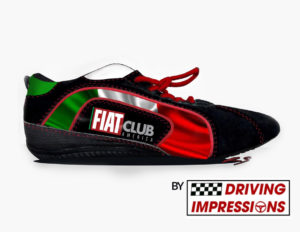This article was originally published on Velocetoday.com on March 3, 2015 By pete
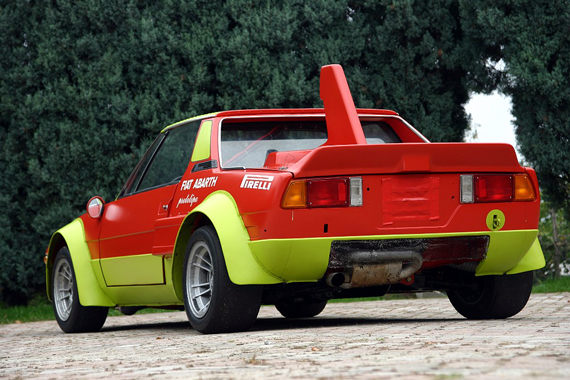
Fiat Abarth X1/9 prototipo, chassis 128 AS 0023003.
Story and color photography by Roberto Motta
The Fiat Abarth X1/9 prototipo made a brief, but impressive, appearance in the rally World during the 1970s, but as soon it was competitive, it became the victim of Fiat politics. The history of the Fiat Abarth X1/9 prototipo started at the end of ’73 season, when the Fiat’s Rally Competition department began work on the project that would replace the 124 Abarth Rally.
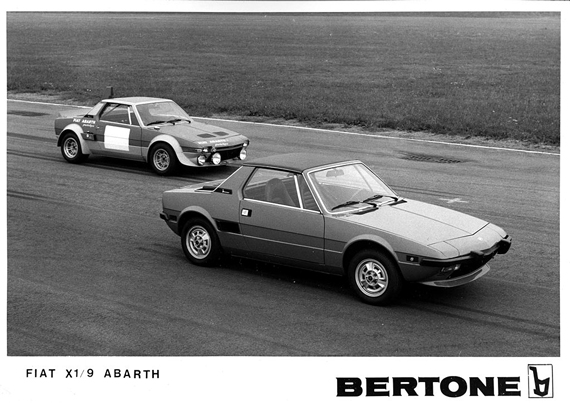
The X1/9 in road version, compared with the 'prototipo'. Here it is driven by the test driver Giorgio Pianta.The car was entrusted for the Swiss F1 driver Clay Regazzoni and the co-driver Gino Macaluso at the 1974 Giro d'Italia Automobilistico.
The Competition department was manned by Renzo Avidano, Abarth’s Director, Giulio Lampredi, the engine designer, Mario Colucci, chassis expert, Giorgio Pianta, the test driver and Gino Macaluso, one of the best Fiat Rally Team’s co-driver and future Fiat Sport Director.
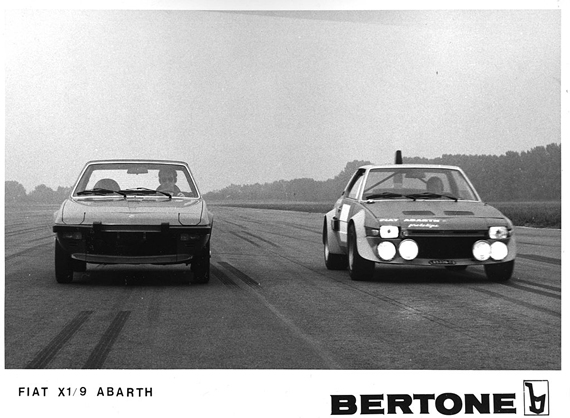
The X1/9 1300cc and the aggressive 'prototipo.'
The first car used for the project was the Chassis 128 AS 0000133 and registered with the license plate number TO H29040. The car featured here is one of the Fiat X 1/9s used in the press presentation, on November 26th, at the Targa Florio’s roads.
Mario Colucci modified the engine compartment so that was possible to put in it a 2-liter Lancia Beta Montecarlo unit.
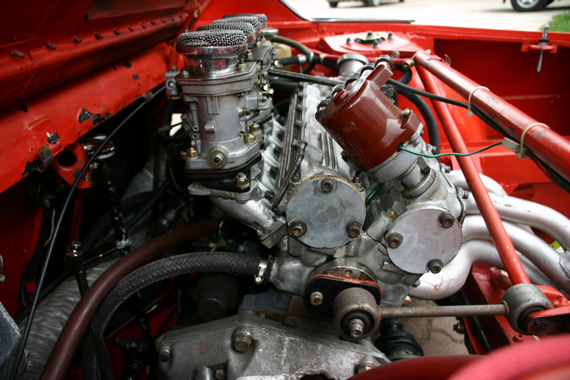
The Type 232’ engine with a displacement of 1756 cc and the Abarth 8 -valve cylinder head is fed by twin Weber 44 IDFs, and able to push out over 170 bhp at 8000 rpm. Chassis 128 AS 0023001.
The car was fitted out with all the necessary competition equipment including racing seats, seat-belt, roll-bar and a fly-off handbrake lever. The chassis was reinforced and equipped with wheels arch extensions, front and rear spoilers and a large air inlet mounted on the engine cover. Improved brakes were fitted and the suspension was updated. The engine and the transmission were sourced from the Group 4 Lancia Beta Coupe.
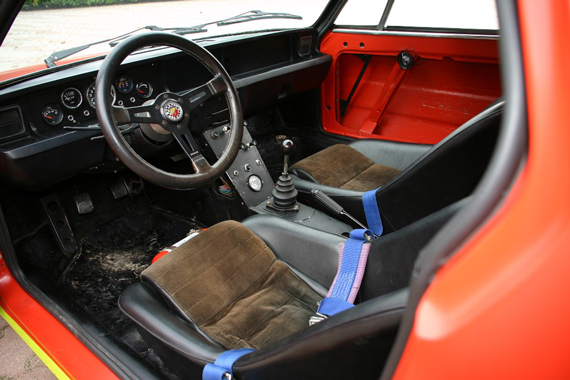
The interior of chassis 128 AS 0023003.
After some testing by Giorgio Pianta, the X1/9 prototipo was enrolled at the Rally di Sicilia which began on March 29, 1974. The car was entrusted to Giorgio Pianta and Bruno Scabini and ran in the Group 5. The car was equipped with an Abarth Type 232 engine, the same 16-valve and 1756cc unit that was normally mounted on the 124 Abarth Rally Group 4. The engine, fed by two Weber 44IDF carburetors, was able to push out 180-190bhp. In the first race, the brutal power delivery to the rear wheels overheated the transmission, and the car ended its race after only 50 meters.
The transmission had also some problem in the car’s second outing, the ‘Quattro Regioni’, where the car used a new bonnet with a periscopic intake. During the event, the X 1/9 was so fast that was fighting for the lead, but on the second stage had some problem with the transmission and broke the third and fourth gears.
Following accurate tests on the Casale and Mugello track, the X1/9 prototipo became a good car, easy to drive and faster than the Lancia Stratos.
On June 29t and 30, 1974, on just its third outing, the X 1/9 won the ‘Rally delle Alpi Orientali’ with Fulvio Bacchelli and Bruno Scabini. Clearly, at this time, the X1/9 was capable to fighting for the World Rally Championship.
During the summer, Abarth prepared five new chassis with a numerical sequence from 128 AS 0023001 to 128 AS 0023005. The first three chassis numbers were definitely registered on September 4th, 1974. The chassis 23001, 23002 and 23003 received the license plate numbers TO L65337, TO L65335 and TO L65336 respectively.
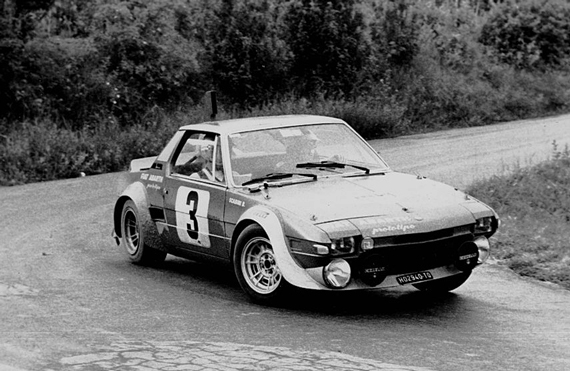
The first 'prototipo', Chassis 128 AS 0000133 at ‘Quattro Regioni’, where the car used a bonnet with a periscopic intake for the first time. During the event, the 'proto' was fighting for the lead, but during the second stage broke the third and fourth gears.
The Abarth management decided that the first two cars would be used in competition while the 23003 would be the development car, the ‘muletto’.
At the Tour de France Abarth entered three cars, and every car was equipped with a different engine. TO L65335, was entrusted to Fulvio Bacchelli, Piero Sodano and Sergio Barbasio, used the ‘Type 232’ engine with a displacement of 1756cc and an Abarth 16-valve cylinder head. TO L65336 was equipped with an 8-valve 1756cc engine and was entrusted to Christine Beckers and Martine de La Grandrive.
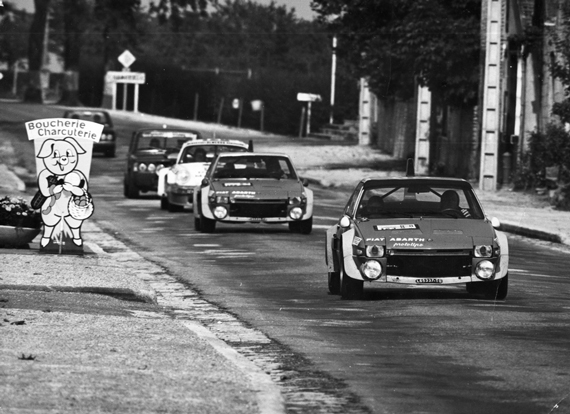
TO L65337, here driven by Pianta, leads the sister car and the Porsche 911 Carrera 3.0.
The first two cars were fed by twin Weber 44 IDFs, and the Power outputs ranged from 170 to 190bhp at 8000rpm. The third car, TO L65337, was equipped with a ‘Type 232G’, a 16-valve engine of 1839cc. This engine was fed by a Kugelfisher injection and was capable to push out 205-210 bhp at 8000rpm. This car was entrusted to Giorgio Pianta and Francesco Rossetti.
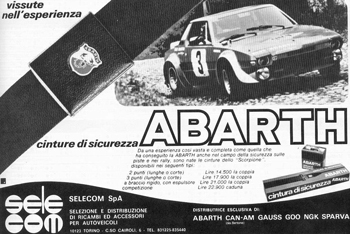
During the Tour de France, the X1/9 prototipo demonstrated that it was a very competitive car, and was so fast that it was fighting with the Porsche 911 Carrera 3.0-liters. Unfortunately, Christine’s car broke the engine during the Deuville-Troyes stage, while Pianta-Rossetti was forced to the stop with broken gears during the test of Magny-Cours. Only Bacchelli completed the event and finished in eighth position.
After the Tour de France, Fiat decided to apply for homologation of the X1/9 in Group 4. In order to give at the car a strong promotional publicity Fiat decided to enter two cars at the Giro d’Italia road rally. The 2° Giro d’Italia Automobilistico was held from October 15 to 19.
The first car, TO L65336, was entrusted for the Swiss F1 driver Clay Regazzoni and the co-driver Gino Macaluso. The second car, TO L65335, was entrusted to Fulvio Bacchelli and Bruno Scabini. The cars were equipped with the 1756cc engine and twin carburetors; both cars were victims of engine failure.
On October 26 and 27, the Fiat Abarth X1/9 prototipo, ‘TO L65335’, entrusted to Bacchelli/Scabini won its first victory at the Rally dei 1000 Laghi. This was a significant result for the Abarth and was also an happy day for Gino Macaluso, in his debut in his new job as ‘Sport Director’.
Some weeks later, on November 30 and December 1, TO L65336 participated in the X1/9’s last event on Italian streets, the Coppa Liburna. Maurizio Verini and Massimo Toriani took the victory while the second car (TO L65335) crewed by Barbasio/Barbasio, withdrew with a damaged transmission.
The tough first season was finished and the Fiat Abarth X1/9 prototipo had done a good job. “The car was fantastic, fast, stable, easy to drive,” said Pianta. “At the time, the X1/9s were competitive, easier to drive and faster than the Stratos. It needed some fine tuning but at this time the X1/9 was ready to compete and could give much satisfaction.”
The Fiat Abarth Rally Team had completed a successful season, and it only remained for Fiat’s management to complete the necessary administration to obtain homologation in Group 4. In the meantime, Bertone had made preparations to begin the production of the chassis to qualify for homologation; the homologated X1/9 would have been ready by end of February, 1975. During the same period a road version of the car was to be seen on the roads around Turin driven by the test driver Giorgio Pianta.
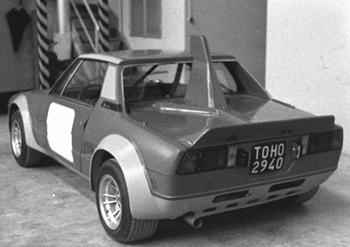
The first car used for the project was the Chassis 128 AS 0000133; Mario Colucci modified the engine compartment so that was possible to put in it a 2-liter Lancia Beta Montecarlo unit.
In December 1974, three cars (TO H02940, TO L65337 and the ‘muletto’ TO L65336) were loaned to Fiat France in order to participate in rallies that accepted cars in the Group 5 prototype class. This strategy was intended to further demonstrate the X1/9’s capabilities and pave the way for homologation in Group 4. Gino Macaluso and Giulio Lampredi had already written up the homologation sheet that previewed the homologation into Group 4 from April 1st 1975.
Unfortunately, at the last minute, rather than submit the document for homologation, the Fiat managers decided to stop the project and to use the 131 Abarth, or the ‘31’ as they called it, in the future WRCs

The 128 AS 0023003 was equiped with a new body, Dallara style, and the 131 Abarth engine. Enrolled to the ‘1980 Giro d'Italia Automobilistico’, and entrusted to Cerutti/Pardini/Stradella won the 4th overall.
After the team received this bad news, the Fiat Sport Director, Gino Macaluso, immediately submitted his resignation to the Fiat CEO, and returned to its profession as an architect. In time, however, Abarth’s men developed the Fiat 131 Abarth and… but that is another story.
Next week: Chassis 128 AS 0023003 in detail


